Multiple extrathymic precursors contribute to T-cell development with different kinetics
- PMID: 20009033
- PMCID: PMC2826228
- DOI: 10.1182/blood-2009-07-230821
Multiple extrathymic precursors contribute to T-cell development with different kinetics
Abstract
T-cell development in the thymus depends on continuous supply of T-cell progenitors from bone marrow (BM). Several extrathymic candidate progenitors have been described that range from multipotent cells to lymphoid cell committed progenitors and even largely T-lineage committed precursors. However, the nature of precursors seeding the thymus under physiologic conditions has remained largely elusive and it is not known whether there is only one physiologic T-cell precursor population or many. Here, we used a competitive in vivo assay based on depletion rather than enrichment of classes of BM-derived precursor populations, thereby only minimally altering physiologic precursor ratios to assess the contribution of various extrathymic precursors to T-lineage differentiation. We found that under these conditions multiple precursors, belonging to both multipotent progenitor (MPP) and common lymphoid progenitor (CLP) subsets have robust T-lineage potential. However, differentiation kinetics of different precursors varied considerably, which might ensure continuous thymic output despite gated importation of extrathymic precursors. In conclusion, our data suggest that the thymus functions to impose T-cell fate on any precursor capable of filling the limited number of progenitor niches.
Figures
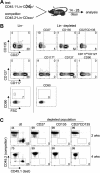
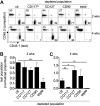
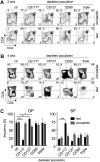
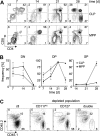
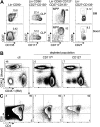

Similar articles
-
The stream of precursors that colonizes the thymus proceeds selectively through the early T lineage precursor stage of T cell development.J Exp Med. 2008 May 12;205(5):1187-99. doi: 10.1084/jem.20072168. Epub 2008 May 5. J Exp Med. 2008. PMID: 18458114 Free PMC article.
-
Lymphoid Gene Upregulation on Circulating Progenitors Participates in Their T-Lineage Commitment.J Immunol. 2015 Jul 1;195(1):156-65. doi: 10.4049/jimmunol.1403219. Epub 2015 May 29. J Immunol. 2015. PMID: 26026063
-
Identification of an NK/T cell-restricted progenitor in adult bone marrow contributing to bone marrow- and thymic-dependent NK cells.Blood. 2010 Jul 15;116(2):183-92. doi: 10.1182/blood-2009-10-247130. Epub 2010 Apr 26. Blood. 2010. PMID: 20421450
-
Commitment and developmental potential of extrathymic and intrathymic T cell precursors: plenty to choose from.Immunity. 2007 Jun;26(6):678-89. doi: 10.1016/j.immuni.2007.05.009. Immunity. 2007. PMID: 17582341 Review.
-
Transcriptional regulation of early T-cell development in the thymus.Eur J Immunol. 2016 Mar;46(3):531-8. doi: 10.1002/eji.201545821. Epub 2016 Feb 12. Eur J Immunol. 2016. PMID: 26763078 Review.
Cited by
-
Eliciting the T cell fate with Notch.Semin Immunol. 2010 Oct;22(5):254-60. doi: 10.1016/j.smim.2010.04.011. Epub 2010 Jun 2. Semin Immunol. 2010. PMID: 20627765 Free PMC article. Review.
-
WBP1L regulates hematopoietic stem cell function and T cell development.Front Immunol. 2024 Nov 1;15:1421512. doi: 10.3389/fimmu.2024.1421512. eCollection 2024. Front Immunol. 2024. PMID: 39555063 Free PMC article.
-
Functional diversity of stem and progenitor cells with B-lymphopoietic potential.Immunol Rev. 2010 Sep;237(1):10-21. doi: 10.1111/j.1600-065X.2010.00933.x. Immunol Rev. 2010. PMID: 20727026 Free PMC article. Review.
-
Extra-thymic physiological T lineage progenitor activity is exclusively confined to cells expressing either CD127, CD90, or high levels of CD117.PLoS One. 2012;7(2):e30864. doi: 10.1371/journal.pone.0030864. Epub 2012 Feb 15. PLoS One. 2012. PMID: 22355330 Free PMC article.
-
Transcriptional network dynamics in early T cell development.J Exp Med. 2024 Oct 7;221(10):e20230893. doi: 10.1084/jem.20230893. Epub 2024 Aug 21. J Exp Med. 2024. PMID: 39167073 Free PMC article. Review.
References
-
- Allman DM, Sambandam A, Kim S, et al. Thymopoiesis independent of common lymphoid progenitors. Nat Immunol. 2003;4(2):168–174. - PubMed
-
- Wada H, Masuda K, Satoh R, et al. Adult T-cell progenitors retain myeloid potential. Nature. 2008;452(7188):768–772. - PubMed
-
- Bell JJ, Bhandoola A. The earliest thymic progenitors for T cells possess myeloid lineage potential. Nature. 2008;452(7188):764–767. - PubMed
-
- Sambandam A, Maillard I, Zediak VP, et al. Notch signaling controls the generation and differentiation of early T lineage progenitors. Nat Immunol. 2005;6(7):663–670. - PubMed
-
- Adolfsson J, Borge OJ, Bryder D, et al. Upregulation of Flt3 expression within the bone marrow Lin(-)Sca1(+)c-kit(+) stem cell compartment is accompanied by loss of self-renewal capacity. Immunity. 2001;15(4):659–669. - PubMed
Publication types
MeSH terms
Substances
Grants and funding
LinkOut - more resources
Full Text Sources
Miscellaneous

